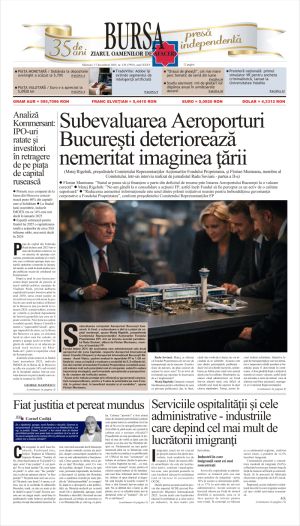• The dollar and Euro are losing their shine to gold and bitcoin
The money market has been hit by instability, and the global economy is swimming in uncertainty following the crisis triggered by the quarantine measures. The whole world is struggling to reopen following the deadlocks caused by the lockdown and the threat of a global recession, and the probability of a reconfiguration of the architecture of the international monetary-financial system after the crisis, is increasing, says Andrei Radulescu, chief economist of Banca Transilvania. He said that he expects the transition to lead to the creation of a digital currency and stressed that a much more important role for China in the post-pandemic world architecture can be predicted.
Besides, the moves on the monetary market are increasingly revealing that money seems to have fallen out of fashion, but on the other hand there is an increasing appetite from investors for gold, considered a safe haven and a safe investment in difficult times, as well as for the bitcoin virtual currency.
In fact, money market movements are increasingly highlighting that money no longer seems to be worn, instead there is a growing appetite of investors for gold, considered a safe haven and safe investment in difficult times, but also for bitcoin virtual currency.
On the other hand, the US dollar is starting to lose its luster, suffering drops in recent weeks, to a one-year low, as concerns about the recovery of the US economy grow and the trade conflicts between the two largest economies of the world - the US and China - are intensifying. Many strategists estimate that this downward trend in the dollar will continue, according to a Bloomberg analysis. It shows that negative real US rates, the relentless spread of coronavirus in America and an increase in global risk sentiment have pushed investors to push the exit button from long-term plans tied to the dollar.
The European currency was also floating in uncertainty, but with the agreement of the European Union on economic recovery, it was brought back to the surface. The European Union has thus managed to move the Euro one step closer to being considered a safe haven for investors. The euro 750 billion fund agreed by EU leaders last week will make the bloc more stable and the issuance of jointly guaranteed bonds will boost the use of the single currency in times of stress. But much remains to be done until the Euro will be seen as a safe currency, although in theory the Euro is an ideal refuge, according to analysts. The combined debt of the 27 EU members was 78% of GDP before the pandemic, lower than that of the United States or Japan, according to Reuters. The region has a current account surplus, making it less dependent on foreign creditors. In addition, almost a third of global payments involve the Euro. Although optimism was evident and the Euro rose against the dollar immediately after the deal, investors do not seem willing to place their money in Euros or dollars.
On the other hand, the chase for gold, which began with the onset of the coronavirus pandemic, continues, and the price is rising as stocks dwindle and fears continue to deepen.
The strong resurgence of the coronavirus and the impact that the new virus could have on the global economy yesterday raised gold prices to a record level, with investors rushing to find shelter. The metal $ 1,944 per ounce on Monday, beating the previous record of $ 1,921 set in 2011. Gold rose about 27% this year. Silver also had a boost, rising more than 6 percent to $ 24.21 an ounce, beating the 7-year record on Thursday.
"Gold is the clear winner of the demand for a safe haven," Stephen Innes, AxiCorp's chief global market strategist, said in a research note, quoted by CNN. And the records may not stop here. UBS analysts expect gold to reach $ 2,000 an ounce before the end of the year, driven by a low US interest rate, a weaker dollar and tensions between the United States and China.
The main driver behind gold's growth has been the declining yields on US government bonds, reflecting the likelihood that the Federal Reserve will be forced to keep interest rates lower for an extended period of time to support the economic recovery, according to Hussein Sayed, chief market strategist at FXTM, quoted by CNN.
In addition to gold, investors seem to have gained confidence in virtual currencies. Yesterday, bitcoin crossed the $ 10,000 per unit level, for the first time since early June, after moving within a narrow range for several weeks and, according to experts, is becoming "digital gold" for investors. However, the virtual currency lacks maturity, according to several investors and analysts interviewed by CoinDesk, and, in addition, is known for its high volatility.
While the gold market, around $ 10 trillion, has enough depth and liquidity to absorb large hedges or safe haven seekers, the market capitalization of bitcoin is only relatively welcoming, at $ 189 billion.
"Gold is like a tank, while bitcoin is more like a fast boat," said Gavin Smith, CEO of Panxora cryptocurrency hedge fund, according to Coindesk, adding: "However, in three to five years, you will see the trajectory of both and you will say that both were a game of inflation".
• Increasing probability of transitioning to a digital currency
Debates on the reconfiguration of the architecture of the international monetary-financial system have multiplied amid intensifying divergences and inconsistencies between the world's major economic blocs, following the Great Recession of 2008-2009, the world's worst economic and financial crisis since World War II, according to Andrei Rădulescu.
The economist states: "In this context are being mentioned the projects for the implementation projects of the "stable cryptocurrencies («stable coin») launched by the International Monetary Fund, the G7, the European Central Bank and the European Commission at the end of the post-crisis economic cycle (the longest in the history of the US economy, the world's largest economy, with a nominal GDP of more than 21 trillion dollars in 2019)".
He added that the incidence of the pandemic, an unprecedented shock in the post-war world economy, has once again brought to the fore the dysfunctions of the international monetary-financial architecture, as reflected by the significant increase in international gold quotations in recent weeks.
Andrei Rădulescu further says: "First of all, the share of the yuan in the SDR basket (special drawing rights from the IMF - ed. note) is very low, although China's nominal GDP exceeded the level of the Eurozone last year, and the gap with the US is narrowing from one year to the next. Given the macro-financial developments of recent years, there is an increased likelihood that the IMF will increase the share of China's currency in the SDR basket on the next revision (normally by the end of this year). Secondly, the share of the US dollar in total international reserves has risen in recent years to about 57.9% in Q1 2020, although the share of US GDP in the world economy has been on a downward trend in recent decades, and US government debt has risen every year to record highs. The share of the Euro in international reserves is about 10 times higher than that of the yuan, although in 2019 China's GDP exceeded the GDP of the Eurozone (in nominal terms, denominated in US dollars). Last but not least, over the last few years (the post-crisis economic cycle) we have witnessed the persistence of the currency confrontation between the main economic blocs of the world, against the background of the implementation of unprecedented relaxed measures to sustain the economic growth rate".
The macroeconomist also points out that after the coronavirus pandemic, the world's major economic blocs have implemented new (unprecedented) easing measures, including unconventional monetary programs of more than $ 6 trillion and fiscal-budgetary and revenue plans of more than $ 10 trillion
"The dysfunctions in the sphere of the international monetary-financial system have led China and Japan to reduce their exposure to US government debt in recent years. In that context, we believe that there is a growing likelihood of a reconfiguration of the architecture of the international monetary-financial system in the coming period (once the lockdown is over), by the leaders of the world's major economies, but we can predict a much more important role for China in the post-pandemic world architecture, the Banca Transilvania economist said.
Mid July this year, Andrew Bailey, the governor of the Bank of England (BoE), said that the central bank is debating internally the possibility of creating a digital currency. Bailey said the central bank is currently conducting a series of investigations into a digital currency managed by the Bank of England. According to him, the implications of this "very important subject" would be reflected in the "nature of payments and society", and the possibility of a digital monetary system could become very real within a few years.
"We are researching the question of whether we should create a digital currency (issued by) the Bank of England. We will continue to research since it does have massive implications for the nature of payments and society. (...) I think within a few years we will be moving to one form or another of digital currency", Bailey said in a video conference.
Bailey's statements thus came at a time when more and more central banks were beginning to work in a coordinated manner (but rather for implementation at the national level) on the idea of implementing a digital currency - especially after Facebook announced its plans for a digital currency called Libra -, or for the clearing and settlement system between banks (at a national level), or even for retail.
Last year, at a meeting of central bankers in Jackson Hole (USA), the former British governor Mark Carney came out with a statement which later made more sense. Carney said a reinvention of the international financial and monetary system was needed, saying central banks needed to jointly launch a digital currency (Syntethic Hegemonic Currency - SHC) to replace the US dollar as a reserve currency in the global economy.
Carney was also saying last year: "The dollar is the global reserve currency. The challenge is that the United States' contribution to the global gross domestic product is declining, while the largest share of payments made, not just financial assets, remains in dollars. In situations like the current one, when the US economy is relatively strong and the Fed is doing the right thing, tightening the (monetary) policy, respectively, the rest of the world's policy is more severe than it should be. In a world where there is limited room for monetary policy, this is a dangerous place you don't want to be in. (...) You don't jump into anything new overnight. What we need in a multipolar world, and now we have several economic engines in a multipolar global economy, is a multipolar (reserve) currency", Carney said.
Riksbank, Sweden's oldest central bank in the world, recently studied the viability of a digital currency issued by a central bank and reached a series of mixed conclusions for central bankers, citing the scope of the change and the cost of the transition to digital. The Federal Reserve in Philadelphia, USA, also determined that such a digital currency developed by a central bank could one day replace the role of commercial banks, but with a potential risk of significant damage to fixed income markets.


























































